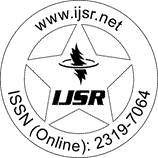Downloads: 116 | Weekly Hits: ⮙1 | Monthly Hits: ⮙1
Research Paper | Physiotherapy | India | Volume 9 Issue 1, January 2020
The Effect of Mental Imagery Techniques Over Strengthening Exercises in Supraspinatus Tendinitis - A Comparative Study
Arun Thachil | Viju Cheriyan
Abstract: BACKGROUND: Supraspinatus tendinitis is defined as the non- traumatic, inflammatory and /or degenerative changes of tendon. It manifests a pain on lateral aspect of shoulder, painful arc and /or pain on full elevation of shoulder and tenderness at greater tuberosity of humerus. Supraspinatus is the most utilized muscle of entire shoulder complex. It provides dynamic as well as static stability to glenohumeral joint. The tendon is subjected to large internal forces even during quite routine activities. Shoulder problems are most common orthopedic complaints referring to physiotherapy after back pain and knee pain. The supraspinatus muscle frequently undergoes rupture, as such it is the main site of impingement. Clinically supraspinatus tendinitis causes about 60 % of all shoulder pain presentations and typically, peaks between the age of 20- 70. The pain is worsen on abduction and elevation of the arm. The primary function of supraspinatus is to compress humeral head into the glenoid fossa and prevent excessive superior translation of the humeral head during functional activities. It is advocated that the lateral rotation and medial rotation strength ratio of supraspinatus muscle significantly less in subjects with shoulder pain and dysfunctions. Usual strengthening exercises help to strengthen the muscle which is not related with fine tuning of the glenohumeral joint. The mental imagery exercise is helping the patient to do the fine control activities and specific strengthening to supraspinatus muscle. AIM The study is to investigate the effect of mental imagery strengthening techniques exercises in supraspinatus tendinitis. METHODOLOGY The population includes patients who were diagnosed having supraspinatus tendinitis. A total of 30 patients were randomly divided into two groups. Group A (Experimental Group 1) was treated with Strengthening Exercises and Conventional Physiotherapy. Group B (Experimental group 2) was treated with Mental Imagery Techniques and Conventional Physiotherapy. The outcome measurement used for the study was SPADI for pain and disability. Goniometer for shoulder abduction ROM. The pretest values were taken on the 1st day before the treatment and posttest values were taken on 21st day. (3 week study). Total duration of the study was 03 weeks. For both the groups the treatment was carried out one session daily for 3 weeks. One session was lasting for 45 minutes. The total data collection period was 6 Months. Student `t` test was used to compare ROM, Pain and disability between groups and within groups. Both groups response to the treatment were analyzed by using paired `t` test. RESULT When considering the parameters like Shoulder ROM (goniometer), Pain and Disability (SPADI). Group B (Experimental group 2) showed highly significant effect when compared to group A (Experimental group 1) (p
Keywords: Mental Imagery Technique, Strengthening Exercise, Supraspinatus Tendinitis
Edition: Volume 9 Issue 1, January 2020,
Pages: 1417 - 1422
Similar Articles with Keyword 'Strengthening Exercise'
Downloads: 0
Masters Thesis, Physiotherapy, India, Volume 11 Issue 8, August 2022
Pages: 737 - 739Effect of Tibial Nerve Mobilization on Pain and Functional Limitation in Subjects with Plantar Fascitis
Monika Yadav | Dr. Monika Sharma [3] | Dr. Shagun Aggarwal | Dr [13336] | Kopal Pajnee
Downloads: 1 | Weekly Hits: ⮙1 | Monthly Hits: ⮙1
Research Paper, Physiotherapy, India, Volume 11 Issue 2, February 2022
Pages: 906 - 910Evaluation of Proprioceptive Training to Restore the Joint's Sense in Ankle Sprains
Dubba Naga Raju | Banavath Gopinaik | Dasarapu Indrani | Brundavanam Rajesh
